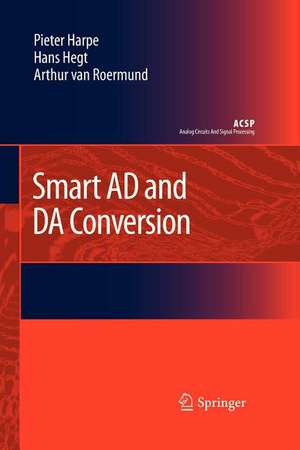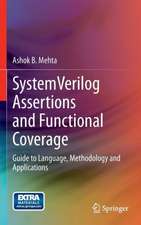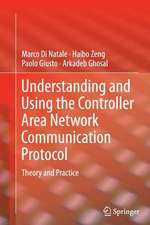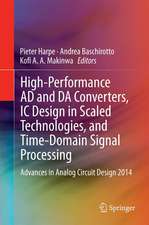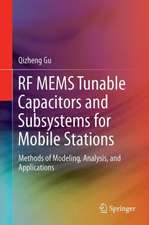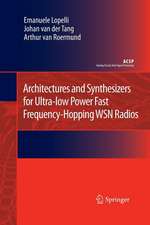Smart AD and DA Conversion: Analog Circuits and Signal Processing
Autor Pieter Harpe, Hans Hegt, Arthur H.M. van Roermunden Limba Engleză Paperback – 5 sep 2012
| Toate formatele și edițiile | Preț | Express |
|---|---|---|
| Paperback (1) | 634.68 lei 6-8 săpt. | |
| SPRINGER NETHERLANDS – 5 sep 2012 | 634.68 lei 6-8 săpt. | |
| Hardback (1) | 640.88 lei 6-8 săpt. | |
| SPRINGER NETHERLANDS – 5 iul 2010 | 640.88 lei 6-8 săpt. |
Din seria Analog Circuits and Signal Processing
- 5%
 Preț: 902.97 lei
Preț: 902.97 lei - 9%
 Preț: 628.98 lei
Preț: 628.98 lei -
 Preț: 388.34 lei
Preț: 388.34 lei - 15%
 Preț: 636.30 lei
Preț: 636.30 lei - 15%
 Preț: 636.80 lei
Preț: 636.80 lei - 18%
 Preț: 941.82 lei
Preț: 941.82 lei - 15%
 Preț: 639.08 lei
Preț: 639.08 lei - 18%
 Preț: 918.48 lei
Preț: 918.48 lei - 15%
 Preț: 631.21 lei
Preț: 631.21 lei - 15%
 Preț: 642.03 lei
Preț: 642.03 lei - 15%
 Preț: 641.85 lei
Preț: 641.85 lei - 18%
 Preț: 887.05 lei
Preț: 887.05 lei - 18%
 Preț: 944.51 lei
Preț: 944.51 lei - 15%
 Preț: 632.55 lei
Preț: 632.55 lei - 15%
 Preț: 641.03 lei
Preț: 641.03 lei - 18%
 Preț: 836.39 lei
Preț: 836.39 lei - 15%
 Preț: 642.18 lei
Preț: 642.18 lei - 15%
 Preț: 639.90 lei
Preț: 639.90 lei - 18%
 Preț: 947.85 lei
Preț: 947.85 lei - 15%
 Preț: 642.51 lei
Preț: 642.51 lei - 15%
 Preț: 631.86 lei
Preț: 631.86 lei - 15%
 Preț: 634.49 lei
Preț: 634.49 lei - 15%
 Preț: 635.47 lei
Preț: 635.47 lei - 15%
 Preț: 640.06 lei
Preț: 640.06 lei - 15%
 Preț: 631.53 lei
Preț: 631.53 lei - 15%
 Preț: 635.65 lei
Preț: 635.65 lei - 18%
 Preț: 941.50 lei
Preț: 941.50 lei - 18%
 Preț: 1112.92 lei
Preț: 1112.92 lei - 15%
 Preț: 636.30 lei
Preț: 636.30 lei - 15%
 Preț: 633.19 lei
Preț: 633.19 lei - 15%
 Preț: 635.80 lei
Preț: 635.80 lei - 18%
 Preț: 888.01 lei
Preț: 888.01 lei - 18%
 Preț: 942.76 lei
Preț: 942.76 lei - 18%
 Preț: 1387.10 lei
Preț: 1387.10 lei - 18%
 Preț: 1115.28 lei
Preț: 1115.28 lei - 15%
 Preț: 633.68 lei
Preț: 633.68 lei - 15%
 Preț: 641.03 lei
Preț: 641.03 lei - 15%
 Preț: 638.57 lei
Preț: 638.57 lei - 15%
 Preț: 642.51 lei
Preț: 642.51 lei - 18%
 Preț: 947.85 lei
Preț: 947.85 lei - 15%
 Preț: 640.71 lei
Preț: 640.71 lei - 15%
 Preț: 640.88 lei
Preț: 640.88 lei - 15%
 Preț: 631.40 lei
Preț: 631.40 lei - 18%
 Preț: 944.19 lei
Preț: 944.19 lei - 18%
 Preț: 944.67 lei
Preț: 944.67 lei - 18%
 Preț: 942.94 lei
Preț: 942.94 lei - 15%
 Preț: 641.20 lei
Preț: 641.20 lei - 20%
 Preț: 555.52 lei
Preț: 555.52 lei - 18%
 Preț: 1003.38 lei
Preț: 1003.38 lei
Preț: 634.68 lei
Preț vechi: 746.69 lei
-15% Nou
Puncte Express: 952
Preț estimativ în valută:
121.44€ • 127.14$ • 100.49£
121.44€ • 127.14$ • 100.49£
Carte tipărită la comandă
Livrare economică 07-21 aprilie
Preluare comenzi: 021 569.72.76
Specificații
ISBN-13: 9789400732575
ISBN-10: 9400732570
Pagini: 180
Ilustrații: IX, 167 p.
Dimensiuni: 155 x 235 x 9 mm
Greutate: 0.26 kg
Ediția:2010
Editura: SPRINGER NETHERLANDS
Colecția Springer
Seria Analog Circuits and Signal Processing
Locul publicării:Dordrecht, Netherlands
ISBN-10: 9400732570
Pagini: 180
Ilustrații: IX, 167 p.
Dimensiuni: 155 x 235 x 9 mm
Greutate: 0.26 kg
Ediția:2010
Editura: SPRINGER NETHERLANDS
Colecția Springer
Seria Analog Circuits and Signal Processing
Locul publicării:Dordrecht, Netherlands
Public țintă
ResearchCuprins
AD and DA Conversion.- Smart Conversion.- Smart DA Conversion.- Design of a Sub-Binary Variable-Radix DAC.- Smart AD Conversion.- Design of an Open-Loop T&H Circuit.- T&H Calibration.- T&H Calibration for Time-Interleaved ADCs.- Conclusions.
Textul de pe ultima copertă
While technology evolution is beneficial for digital circuits, it can cause performance limitations for analog circuits. To benefit from the technology evolution for analog circuits as well, the smart concept aims at improving the analog performance by using digital intelligence. In Smart AD and DA Conversion, the smart concept is applied to AD and DA converters by using on-chip intelligence to detect analog imperfections and to correct for them.
First, general trends and challenges in data converter design are studied and a generalized view on smart conversion is introduced. Then, the smart concept is applied to solve specific imperfections in two design examples: a sub-binary variable-radix current-steering DA converter and a time-interleaved open-loop track&hold circuit. In both cases, the developed concepts are supported by theory and implemented test chips. The examples show that the smart concept can be successfully applied to improve the performance of AD and DA converters with respect to chip area, power consumption, static accuracy and/or dynamic accuracy.
First, general trends and challenges in data converter design are studied and a generalized view on smart conversion is introduced. Then, the smart concept is applied to solve specific imperfections in two design examples: a sub-binary variable-radix current-steering DA converter and a time-interleaved open-loop track&hold circuit. In both cases, the developed concepts are supported by theory and implemented test chips. The examples show that the smart concept can be successfully applied to improve the performance of AD and DA converters with respect to chip area, power consumption, static accuracy and/or dynamic accuracy.
Caracteristici
The feasibility of relevant smart AD and DA converter concepts to improve their performance is investigated. For both AD and DA converters, the following aspects are taken into account: Selection of relevant smart concepts to improve the performance Development and analysis of the selected smart concepts, including methods for detection, processing and correction Implementation and evaluation of the selected smart concepts Includes supplementary material: sn.pub/extras
